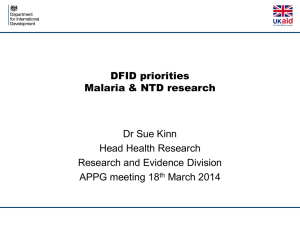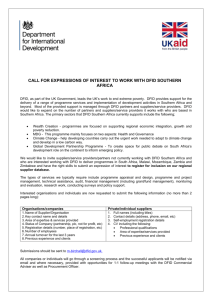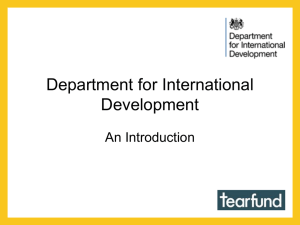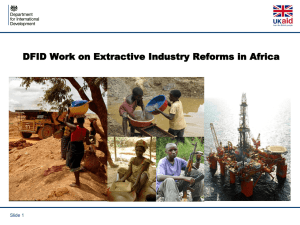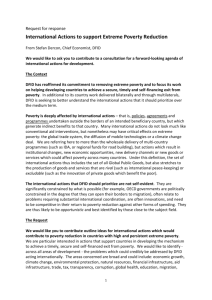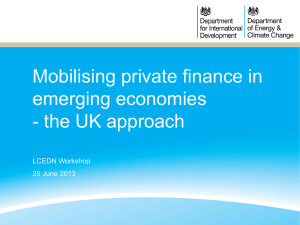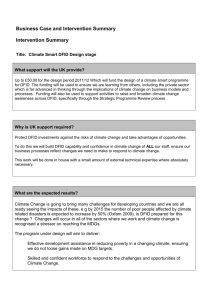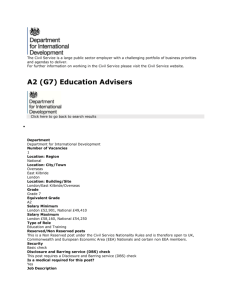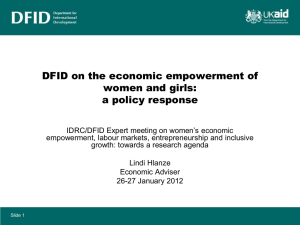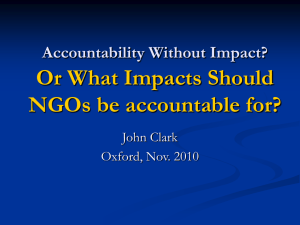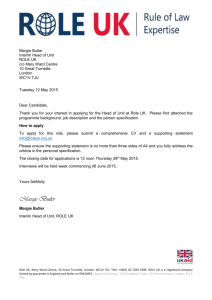Research and Evidence Division. Why it matters for advisers?
advertisement
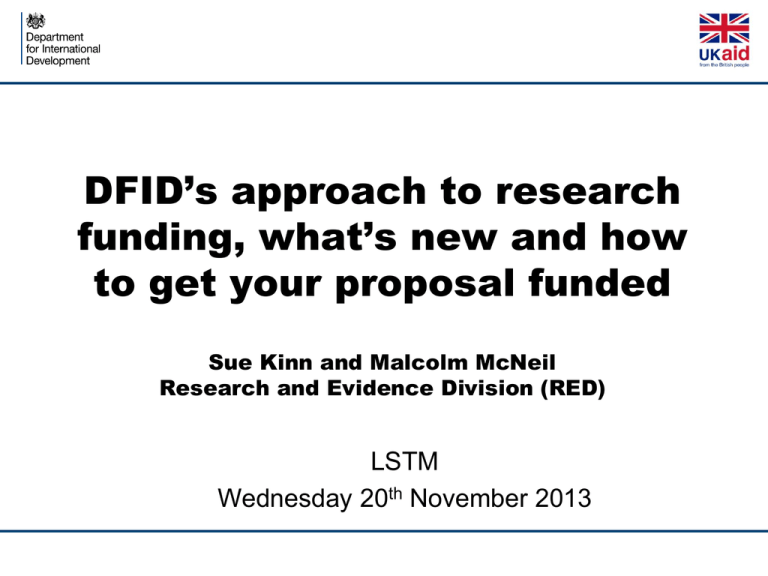
DFID’s approach to research funding, what’s new and how to get your proposal funded Sue Kinn and Malcolm McNeil Research and Evidence Division (RED) LSTM Wednesday 20th November 2013 How DFID programmes work • Working through governments (bilateral) – Country-led approach • With other donors and aid agencies – Poverty reduction strategies – Harmonisation and alignment – Longer term and more predictable aid • Accountability and tackling corruption • Encourage private sector, including NGOs and civil society providers • Post-conflict and Fragile states (500 million people) • Long term improvements to basic services Current issues in DFID • Value for money • Impact of aid spending on the poor • Transparency • Accountability • Working with new donors – Foundations – Emerging economies • Working with the private sector • Avoiding duplication DFID priority areas • Climate and environment • Malaria and neglected tropical diseases • Reproductive, maternal and newborn health • Nutrition and food security • Water and sanitation • Wealth creation and private sector • Support to civil society • Humanitarian and emergency response Why do we need research? (1) • Many current advances in development rest on evidence from previously conducted research, some quite old. • The best researched areas (where there has been investment in new products and greatest evidence on which to base decisions) are those where the greatest progress has been made, e.g. vaccinations, child mortality. • Evidence of what works, new products and innovations are often thin, poor quality or lacking in many areas of development. Why do we need research? (2) • Without research, development will go backwards - we must continue to innovate to meet the evolving needs of the poor. – Pathogens develop resistance to prevention and control mechanisms – New diseases emerge and others can become more virulent and cause disease. – Natural disasters and shocks can have a devastating impact on people’s lives and livelihoods. • We need to understand how best to deliver effective services at scale • We need to understand key development questions to support best policy choices Research and Evidence Division Responsible for delivering the Secretary of State’s major priority, to make DFID more systematic in using evidence and thereby have more development impact. RED’s mission is to identify and generate the best evidence, knowledge, technology and ideas to improve the effectiveness of development and convey these to inform and influence policy, programmes and practice for poverty reduction. Research and Evidence Division Director and Chief Scientific Adviser Deputy CSA Chief Economist QAU Research Commissioning: Evidence & Evaluation Professional Cadres Agriculture Climate & Env Human Dev Growth Governance, Conflict & Social Development Evaluation Evidence into Action Global statistics South Asia Hub East Africa Hub Health, education, climate, environment, infrastructure, livelihoods, private sector, economics, statistics, governance, conflict, humanitarian, social development DFID’s Research Programme • Three broad aims: – Development of new technologies which will have an impact on poverty – Better and more cost-effective ways of delivering aid and development assistance – Understanding the context for policy choices and delivery • To provide new knowledge and rigorous evidence to address the challenges of poverty reduction • Research must be seen as a development intervention – research which will have development outcomes and impact. • Research needs to be grounded and practical, delivering high quality global public goods DFID commissioned research (1) First consideration ALWAYS is high quality BUT DFID-funded research has significant differences from that commissioned by research councils and charities: • Focus on: – Poverty reduction – Problems being faced in developing countries, by Governments, service providers and citizens. – Getting research findings into policy and practice (GRIPP) quickly. DFID commissioned research (2) First consideration ALWAYS is high quality • Strong focus on the development part of R&D. • Actively encourage partnerships between institutions in the north and those based in low-income countries, to enable capacity building and genuine collaboration • Increasingly encouraging partnerships between the public and private sectors. How has research in DFID changed over past 10 years? • Central Research Department - expertise across sectors • Move to more open competition for funding • Increase in external peer reviewing • Appointment of Chief Scientific Adviser • More accountability/reporting about research • Need to include research uptake/pathways to impact • Research and Evidence as a separate independent Division • Set proportion of DFID budget for research (3% of total) • Changing thematic priorities Changes in DFID’s views on evidence • External Research Advisory Group established • Higher priority for evidence in new programmes – Business cases, theory of change and Quality Assurance Unit • Commissioning and publishing Evidence products – Evidence papers – Systematic review programme • Creation of the Evidence into Action team • Creation of the South Asia and East Africa research hubs • Improved Links with Govt Office of Science What does DFID want to achieve with its research? • • • • • • Innovation and risk as well as more established research Mix of research methods Working with the private sector Capacity building in various ways GRIPP Effective partnerships and influencing Research challenges • How to be more effective in getting research into policy and practice (GRIPP) • How to use programmes to build the evidence base where no evidence exists (getting research out of practice – GROP) • How to better measure impact over time • Global public goods vs local country needs • Long term research timetables vs need for a rapid policy response • Improved access to timely evidence for policy and decision makers Key challenge for RED • To demonstrate that the investment in evidence is changing working approaches in DFID, and leads to better developmental impact and VFM Key risk for RED • Evidence investment by DFID does not deliver, or fails to achieve long-term support from other divisions Funding for research • RED’s central research budget represents 3% of DFID’s total budget in FY 2013-2014 (approx £330m) • RED’s funding last financial year was balanced across: – UK institutions – 31% – Overseas and international institutions – 36% – Southern institutions – 33% – Includes strengthening of tertiary education sector in Africa and Asia Funding to? • Provision of core funds to international research organisations (e.g. CGIAR, icddr,b) • Product Development Partnerships (PDPs) • Research Programme Consortia (RPCs) • Direct funding other than to RPCs (e.g. TRAC, lab-lite) • With UK Research Councils (MRC, ESRC) • Collaboration with other donors (SL@B, HRCS) Health research portfolio • Communicable diseases – PDPs, RPCs, MRC, JGHT, TDR, icddr,b, TRAC, NTD ir, Lablite • Reproductive, maternal and child health – RPCs, PDP, MRC, JGHT, HRP, SL@B • Health systems – Alliance, HSR, MRC, • Non-communicable diseases – RPC, ?tobacco Funding modalities • Product Development partnerships – Aeras, DNDi, FIND, IAVI, IPM, IVCC, MMV, TBA, PATH • Research Programme Consortia – 9: health systems (including one led by LSTM), strengthening delivery, FP, HIV, nutrition, mental health, systematic reviews • Joint with UK funders – MRC, ESRC and WT • WHO based programmes • Alliance, HRP, TDR • Other – Saving lives at birth, research capacity strengthening, icddr,b, TRAC, Lablite Estimated health research spend 2013-14 other 14% PDPs 33% WHO 10% RC 18% RPCs 25% • PDPs (25.6m) • RPCs (19m) • RC (13.5m) • WHO (7.7m) • Other (10.8m) What do funders want from research(ers)? • High quality research and outcomes • Answer timely relevant questions • Value for money • Potential for impact • Safe pair of hands – – – Technical Institutional/Managerial Financial/Budget Universities, think tanks, NGOs, UN agencies etc. • Highest technical quality and respond to DFID requirements • Who is best placed to answer the research questions – including the ‘value-added’ aspects for DFID? • What are the aims of the funding – research alone, capacity building, partnership with developing country researchers/policy makers? • What are the transaction costs for DFID? • Where is the greatest value for money? • Research uptake – not advocacy Your research should include • • • • • • Innovation and risk as well as more established research Mix of research methods Working with the private sector Capacity building in various ways GRIPP Effective partnerships and influencing Technical issues • Make sure the proposal directly addresses the call or priorities of the funder • Do not dress up your pet project to fit the call • Use appropriate research methods • Match the level of ambition to the budget/time/resources being requested • Make sure all people named (and budgeted) have a clear added value for the specific research proposal Institutional/Managerial issues • Don’t develop proposals beyond the institutional capacity to deliver • Keep things as simple as possible avoid excessive complexity in governance arrangements or technical approaches • Use appropriate partners to bring required experience – Spell out and justify the role of senior/expensive staff – Use junior/inexperienced staff appropriately, not just to save money • Don’t underestimate managerial and financial requirements to deliver research effectively Financial/Budget issues • Technical proposals must be closely linked to the budget • Do not include items not permitted by the funder • Avoid excessive daily rates for staff – funders will calculate how they compare with published salary scales • Avoid excessive spend on travel and conferences • Make sure all budgets are clear and easy to follow • Make sure budgets are apportioned fairly between partners Research uptake • Do you have a research uptake strategy? • REF pathways to impact – Relevant research questions addressed – Research findings communicated appropriately – Building capacity to understand, do and use research – Open access publishing Capacity building • Check if funding is available for capacity building • Integrate throughout the proposal • Gender balance • Mix between long-term and short-term activities • Wider than the research itself (e.g. technical, managerial, finance, planning, communication, research synthesis) Stakeholders and communities • Check if funding is available • If engaging, take it seriously • Integrated throughout but with engagement as early as possible • Stakeholders will give you a full understanding about ‘norms’ and cultural issues • Feedback to participants throughout and at the end of the process Keep in mind: • Write up research quickly • Don’t overclaim findings • Don’t bury negative findings • Make information accessible to non-specialists • Keep thinking about GRIPP and impact • Use mixed methods including economic evaluation, social science etc. • Liverpool STM very strong on these aspects What puts research funders off? • Late and incomplete applications likely to be rejected • Rushed applications are always lower quality • Asking clarification questions that are already answered in call documentation/online help or other sources • Asking questions that are only relevant if you get through to the next stage • Applications that are too long, or do not follow instructions • Annexes included which have not been requested • Obscure labelling of electronic files Top tips and blunders to avoid • Read the terms of reference for the call carefully – check that you are responding to what is wanted • Please, please!! Do not shoehorn your favourite research proposal into a call where it does not fit (surprisingly - we can tell) • Describe clearly what you propose to do and achieve • Show how the research is responding to needs described in the call • Be honest about your own expertise and capacity – make clear how any shortcomings will be addressed • Answer the questions in the application form in plain English • Stick to word/page limits and don’t change the format • Do not add a title page if not required • Name all your electronic files sensibly – amazing how many arrive labelled “DFID application” – but from whom? Current opportunities are advertised at: https://www.gov.uk/funding-for-development-research • Health Systems Research • Neglected Tropical Diseases Implementation Research (just closed) • Building capacity to use research evidence (closed) • MRC responsive system/African Research Leaders • R2HC – health in humanitarian crises • WHO programmes calls • EDCTP All outputs recorded on ‘Research for Development’ • http://r4d.dfid.gov.uk/ •● R4D gets 150,000 visits & 100,000 downloads per month. ● Usage has increased by over 40% since March 2012 ● 41% of visitors to R4D access it from a Southern country: 11% from DAC Least Developed and Low Income Countries Thanks
